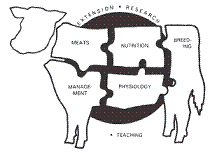Animal Science, Department of

Nebraska Beef Cattle Reports
Date of this Version
2019
Citation
2019 Nebraska Beef Cattle Report
Abstract
A 2 × 3 factorial finishing study evaluated traditional or brown midrib corn silage fed at three inclusions in finishing diets. Silage inclusion was 15%, 45%, or 75% inclusion (DM basis) for 70 days followed by 15% inclusion for the remainder of the finishing phase. Cattle were ultrasounded twice to calculate backfat deposition rate for a target backfat of 0.55 inches, as cattle were fed longer if silage inclusion was 45 or 75/15%. Cattle fed 45% or 75/15% silage inclusion had greater final body weight (BW) and days on feed, but higher feed:gain (F:G) than cattle fed 15% silage. Daily gain was greatest for cattle fed 15% silage, but not different between cattle fed 45% and 75/15% treatments. Cattle fed 45% and 75/15% silage had greater final hot carcass weight (HCW) and longissimus muscle (LM) area than 15% but fed for 28 additional days. Dry matter intake was greater for cattle fed brown midrib (bm3) silage but gain or F:G were not affected. Backgrounding cattle on a low energy diet followed by a high energy diet resulted in similar growth performance and carcass endpoint as cattle fed a consistent inclusion of silage throughout the entirety of the feeding period. Feeding cattle 45% or 75/15% silage resulted in larger carcass weights and more days on feed (DOF) than cattle fed 15% silage for the finishing period. This resulted in greater returns for cattle fed 45% and 75/15% silage diet as compared to cattle fed a high energy 15% silage diet throughout the feeding period.
Included in
Large or Food Animal and Equine Medicine Commons, Meat Science Commons, Veterinary Preventive Medicine, Epidemiology, and Public Health Commons


Comments
Copyright © The Board Regents of the University of Nebraska.